Catcher Blocking The Plate In Little League Without The Ball

Sam from New York asks:
In a Little League game with runners on 1st and 2nd and no outs, the batter hits a single up the middle and the runner on 2nd rounds 3rd on his way home. The throw is off the mark forcing the catcher to move five feet up the 3rd base line to catch the ball and blocks the runner from continuing down the line to score. The runner is not allowed to collide with the catcher and is suppose to slide. However, it the runner slides he will be to far away from the plate. Does the runner automatically get rewarded the base due to interference? If he runs around the catcher he is completly out of the base line. It's it true that the runner should have unimpeded access to the plate and the catcher can only block the plate but not the line?
Rule 7.08(a)(3) in the Little League rule book states that "a runner is out when the runner does not slide or attempt to get around a fielder who has the ball and is waiting to make the tag." This means that any time the fielder has the ball and is about to attempt to make the tag the runner needs to either slide or attempt to avoid the tag (if he goes out of the base line he is out). This is in place in order to prevent runners from coming into home plate and running over the catcher.
However, if the catcher, or any fielder for that matter, is standing in the middle of the base path or blocking the base without the ball, then assumingt that a play is not yet being made on the runner, type B obstruction should be called. Type B obstruction takes place when a play is not being made on the runner who is obstructed and it is a delayed dead ball. Then, once the play is over, the umpire should call time and award the runner the base he would be awarded as on type A obstruction.
Answered by: Jonathan Bravo
Keywords: Runners, LL Rule 7.08(a)(3)